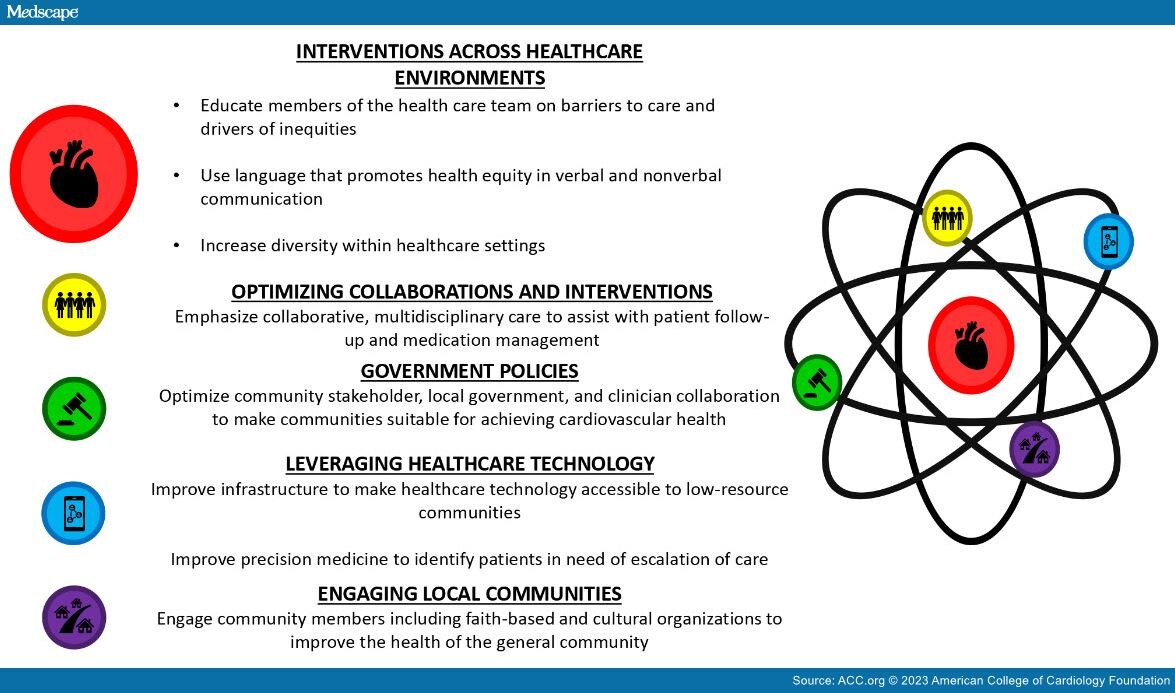Introduction
Attaining ideal cardiovascular (CV) health and improving overall well-being for individuals and communities necessitates a strong focus on preventing CV and related diseases. Prevention science aims to use evidence-based strategies to reduce disease risk factors and promote health holistically. The 2017 American Heart Association (AHA) Scientific Statement on Implementation of Prevention Science to Eliminate Health Care Inequities in Achieving CV Health examines barriers to ideal CV health, focusing on leveraging resources to reduce health care inequities and enhance preventive CV care.[1] The AHA discusses interventions in health care settings, technology utilization, interdisciplinary collaborations, community engagement, and health-related government policies, providing evidence-based examples of equitable CV health.
Direct Patient Care
Health care environments that provide direct patient care are pivotal in addressing inequities and promoting effective preventive care.[2] Firstly, education for the health care team is crucial and can be improved by integrating training on barriers to care and inequities into formal education for all health professionals.[3] Enhancing diversity within health care settings, encompassing racial/ethnic, geographical, and gender diversity, facilitates better access to care, quality of care, and cultural awareness, fostering trust and improved CV outcomes.[4] Effective communication is paramount for promoting health equity, and using language that avoids stigmatization, adopts person-first phrasing, and uses specific terms to describe subpopulations can create a holistic environment. Communication in the patient's preferred language and at their comprehension level encourages active engagement and adherence to treatment plans. Lastly, improving health literacy at the patient-care level is critical. Tailoring information to patients' literacy, language, and linguistic needs, along with promoting shared decision making, empowers them to take an active role in managing their health.
Health Care Technology
Health care technologies, including electronic medical records (EMRs) and telehealth visits, offer promising potential for enhancing preventive CV care. The benefits of technology include improved access to health records and diagnostic testing, along with enhanced communication with health care teams, leading to better longitudinal tracking and management of key health metrics. However, concerns remain about the inequality in their adoption by both patients and health systems. EMRs have varying functionality across health care settings, with cost limitations hindering their comprehensive implementation in low-resourced community-based clinics. Longitudinal data provided by EMRs are important for effectively managing chronic conditions such as hypertension and diabetes mellitus. Telehealth has seen exponential growth in health care delivery and provides an alternative and safe option for the continuation of care of chronic medical conditions.[5] However, equitable implementation and access to telehealth services remain challenging and require further improvement.[6] To improve CV preventive care for all, technological capacity should prioritize standards allowing low-resource communities access to high-quality internet services and virtual portals. Although technology cannot resolve all barriers to care, it serves as a valuable tool to help mitigate certain inequities.[7]
Multiprofessional Collaborations
Multidisciplinary approaches emphasizing collaborative care effectively reduce health care inequities by providing preventive interventions that address social determinants of health (Table 1). Evidence supports team-based care, showing significant improvements in hypertension control, especially in under-represented populations. Community health workers (CHWs), particularly in under-resourced areas, serve as frontline public health officials, bridging communities with health care systems. Engaging CHWs in a team-based care model improves CV risk factors in patients. Corporations, including pharmaceutical companies, pharmacies, and health insurance companies, can contribute to mitigating health care disparities through identification of vulnerable populations and facilitate resource allocation to areas with the most urgent needs.
Local Communities
Community engagement is a vital strategy for reducing and eliminating CVD inequities. Collaborative interventions involving community members have proven effective in changing health behaviors, benefiting from the community's expertise and credibility, while leveraging existing infrastructure for sustainability. Overlapping boundaries between clinical and community settings by placing health care professionals in everyday locations (e.g., grocery stores, barber shops, and schools) blurs the boundaries between health care and the community, yielding significant improvements in health inequities.[8] Strengthening collaborations between federally qualified health centers and academic medical centers can also enhance access to care for individuals with lower socioeconomic status through health education programs and shared training initiatives.[9] Engaging multiple stakeholders, including community leaders, patient representatives, and academic medical centers, can contribute to increased racial, ethnic, and gender diversity.[3]
Government Policies
Community stakeholders, local governments, and clinicians share a common interest in enhancing the health of the communities they serve, fostering an environment conducive to innovation. Government policies at both local and national levels play a significant role in reducing health care inequities and promoting ideal CV health. For example, population-level interventions, such as taxes on sugar-sweetened beverages or portion-size limitations, require support from local or state governments. The Centers for Medicare and Medicaid Services (CMS) have recently embraced health equity measures, focusing on health care disparities and improved reporting of individuals with health-related social needs as part of their quality-improvement activities.[10]
Conclusion
Achieving optimal CV health requires a coordinated, multidisciplinary approach. By implementing clinical interventions, leveraging technology, enhancing collaborative care across various disciplines, and augmenting community engagement alongside improvements in health care policy, inequities can be mitigated and social justice promoted within CV health care (Figure 1).
Figure 1: Interventions Across Health Care Environments. Courtesy of Park JK, Balarbar N, Brumley C, Mehta A.
Credit:
Maskot / Getty Images
© 2023 American College of Cardiology Foundation. All rights reserved.








Comments